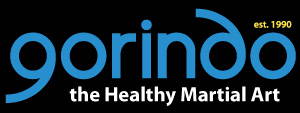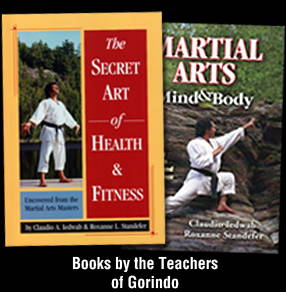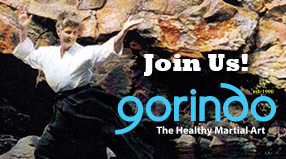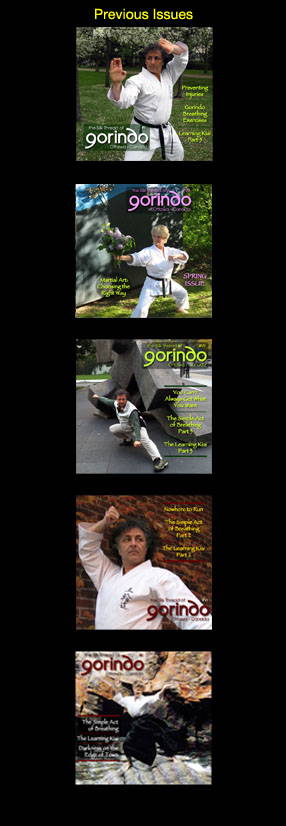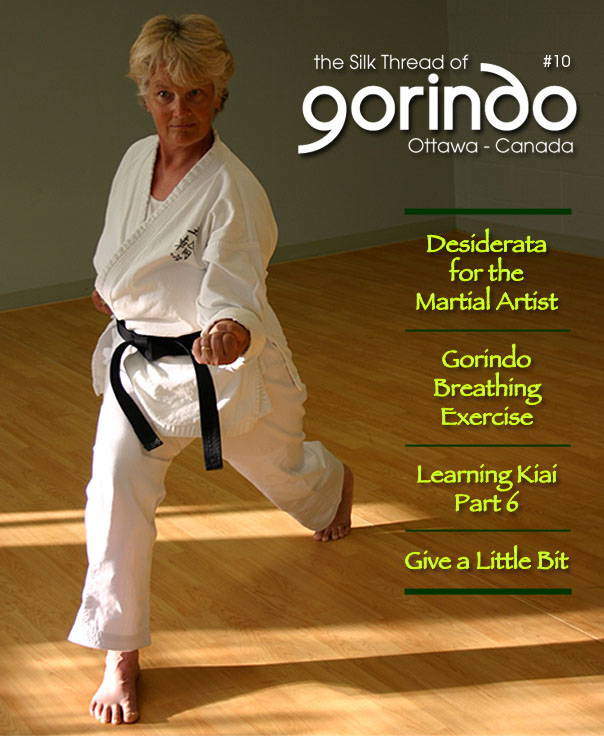
The Silk Thread of Gorindo - Ottawa - Canada
Issue 10
- Desiderata for the Martial Artist
Photo cover Roxanne Standefer sensei, August 2011, by Claudio Iedwab
The Learning Kiai (Part 6)
< read Part 5 (previous issue)
One foot in front of the other
A good teacher and an established curriculum will insure that the building blocks of accurate technique are laid out in a progressive fashion with each step within the ability of the student both physically and mentally. New challenges must be presented as part of the realm of the possible, so that the student will have a feeling of accomplishment at the end of the day.
Some students learn very quickly at the beginning and then seem to slow down as they progress. Others, who find their selves “stuck” going over endless basics before they can get a technique, will sometimes “click” at a certain level and start moving very rapidly in their assimilation of the material. Everyone must go forward at their own pace and expect fluctuations and plateaus along the way.
Small steps and big strides
The Learning Kiai suggests that the student must be content sometimes with small increments of improvement. Martial artists concern themselves with their own individual progress and do not look around to measure themselves against others. The training stresses that everyone has their own learning curve and that it does not always stay the same throughout the course of one’s progress on the path.
 The problem with competition
The problem with competition
This is why teachers of Gorindo discourage competition among their students, feeling it can impede progress and distract from the important lessons in the training. It is also why the colored belt system can be a valuable tool for the martial art school if it allows students of different experience to train together at the same time. The student does not have to worry about graduating with his “class” and will have the benefit of observing and being assisted by senior students. The advanced student has the opportunity in a general level class to practice the basics again and use these exercises, called 'kihon', to incorporate subtle changes and corrections to his or her own technique.
Some students conclude that if they are not meant to (or allowed to) compete with others than they must compete with themselves. The Learning Kiai would add a barometer of caution to this notion. In the martial arts, as we’ve said, the learning proceeds on so many different levels at the same time that expecting a visible, measured, improved performance from one day to the next may be unrealistic. Improvement may be obvious to the teacher and not the student who is looking for giant steps.
The Learning Kiai will involve periods of revisiting, re-evaluation and re-building of technique and attitude. Just because a certain benchmark has not been achieved or bettered according to schedule or personal expectation, does not mean that progress is not happening. The martial artist must be prepared to break down technique, habits and attitudes in order to build on a firmer foundation. The humility, clarity and confidence that this requires is not necessarily born in one’s character, but must be learned and practiced. In this exercise of the head and the heart, (or the mind and the spirit), the physical techniques become mere tools for building, shaping and finishing the real work; that is, the development of character.
The dojo should provide the environment where this work and practice can be done. If a student feels they are being compared to others or observed for faults in a competitive way by their peers then they will not practice what needs to be improved.
The Learning Kiai develops powers of observation with all the five recognized senses, and a few that are not named. Humans tend to rely on their conscious visual observation, but a martial artist uses all of his awareness to anticipate an attack and respond appropriately. A good teacher will use a variety of teaching methods; including demonstration, explanation, and trial and error, so that the student can both observe and discover a range of responses when learning technique. The beginner will imitate and follow the direction of a leader. He has to be taught to observe general movements and the fundamentals of stances, before worrying about hand positions and smaller details.
Noticing the little things
The more advanced student, when learning something new, is able to perceive immediately what basic principles are at work and move accordingly. He or she can then focus on what variation or new manipulation is being offered by the technique being presented. It is in this way that the martial artist develops a repertoire of responses that can be called upon instinctively. To reach this stage of advanced development requires a systematic method of learning, personal reflection and analysis and of course, practice, practice, practice. Without the Learning Kiai of the martial arts, this integration of observation and response will not occur.
Simple things, like placing the foot a certain way, keeping the center of gravity low, and the head in line with the spine, usually doesn’t seem very important to the beginner, who is eager to learn the fancy stuff. The more advanced student observes these features first, knowing that having the basics correct is the foundation for the more complex technique. A well-developed Learning Kiai enables the student to find enjoyment and satisfaction from recognizing the vocabulary of principles that becomes, through practice, the language of movement of the martial artist.
Attention to detail is one of the hallmarks of the trained martial artist. Distinguishing what is important from what is distraction is part of the training process. The beginner is trying to make sense out of learning the basics of technique. He usually feels that he can’t think of all the things he needs to remember, all at the same time. If he gets the feet and knees right in the stance, he discovers that his left hand is doing what his right is meant to, or he’s holding his breath or turned the wrong way to get there. With practice and guidance from a teacher, these challenges will be solved and movement will become more relaxed. The key is to build technique step by step, slowly and surely, with lot of encouragement from the outside and patience from within.
Excerpt from “Martial Arts Mind & Body” by Claudio Iedwab & Roxanne Standefer. See also their e-books available at askSensei.com >>
Photo by Claudio Iedwab - "LIght & Balance" (Roxanne Standefer)
- Desiderata for the Martial Artist
« Click the Subscribe link on the left
